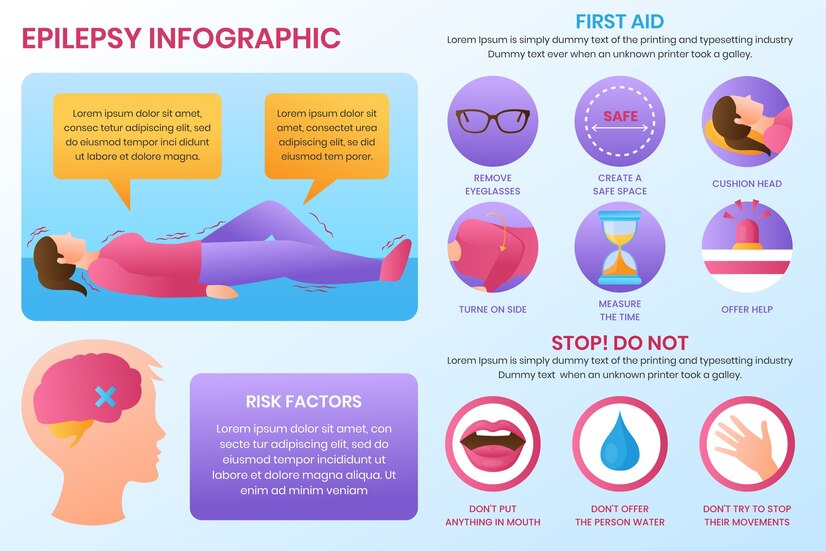NCLEX Questions cover a wide range of nursing specialties, including obstetrics, geriatrics, community health, and psychiatric nursing.
NCLEX Seizure Questions - NCLEX Questions on Seizure
Seizure NCLEX Questions Test Strategies
NGN Case Study:
Patient's history A 23-year-old female patient presents with a history of generalized seizures. The patient reports having absence seizures, which typically last a few seconds and cause her to appear daydreaming. The patient has also had tonic- clonic seizures in the past, characterized by muscle stiffness, loss of consciousness, and jerking of the limbs. The patient has a family history of epilepsy and has been diagnosed with a genetic disorder.
Nurse's notes:
- Patient presents with a history of generalized seizures, including absence and tonic-clonic seizures
- Patient appears to have a genetic disorder causing seizures
- Patient reports absence seizures last a few seconds and cause her to appear daydreaming
- Patient reports tonic-clonic seizures characterized by muscle stiffness, loss of consciousness, and jerking of the limbs
Physician's order:
- Administer antiseizure medication (phenytoin)
- Monitor for side effects of medication (swelling and bleeding of the gums, headache, nausea, vomiting, constipation, dizziness, feeling of spinning, drowsiness, trouble sleeping, or nervousness)
- Instruct patient to maintain good oral hygiene and avoid antacids, supplements, and milk that may interfere with medication absorption
- Advise patient that birth control pills may be less effective due to drug interaction with phenytoin
Lab values:
- Phenytoin level: 10 mcg/mL (therapeutic range: 10-20 mcg/mL)
Question 1.
What are the primary reasons for administering phenytoin to the patient in this case study?
(a) To control the symptoms of the patient's genetic disorder
(b) To treat the patient's absence seizures
(c) To prevent tonic-clonic seizures
(d) To reduce the patient’s risk of developing side effects
(e) To maintain good oral hygiene
(f) To prevent interference with medication absorption
(g) To ensure the effectiveness of birth control pills
(h) To monitor for changes in the patient's lab values
Answer:
(c) To prevent tonic-clonic seizures
(f) To prevent interference with medication absorption
(g) To ensure the effectiveness of birth control pills
Explanation:
(a) To control the symptoms of the patient's genetic disorder is correct. The patient has been diagnosed with a genetic disorder causing seizures and phenytoin is being administered as an antiseizure medication to control these symptoms.
(b) To treat the patient's absence seizures is correct. The patient reports having absence seizures, which phenytoin is intended to control.
(c) To prevent tonic-clonic seizures is correct. The patient has a history of tonic-clonic seizures and phenytoin is intended to prevent these seizures from occurring.
(d) To reduce the patient's risk of developing side effects is incorrect. The physician's order instructs the nurse to monitor for side effects of the medication, not to reduce the risk of developing side effects.
(e) To maintain good oral hygiene is incorrect. The physician's order instructs the patient to maintain good oral hygiene, but this is not the primary reason for administering phenytoin.
(f) To prevent interference with medication absorption is correct. The physician's order instructs the patient to avoid antacids, supplements, and milk that may interfere with the absorption of phenytoin.
(g) To ensure the effectiveness of birth control pills is correct. The physician's order advises the patient that birth control pills may be less effective due to a drug interaction with phenytoin.
(h) To monitor for changes in the patient's lab values is incorrect. The lab values state that the patient's phenytoin level is in the therapeutic range, but this is not the primary reason for administering phenytoin to the patient.
Question 2.
What is the diagnosis of the 23-year-old female patient based on the given scenario?
(a) Migraine
(b) Epilepsy
(c) Multiple sclerosis
(d) Parkinson's disease
(e) Depression
(f) Stroke
(g) Alzheimer's disease
(h) Huntington's disease
Answer:
(b) Epilepsy
Explanation:
(a) Migraine: Incorrect Migraine is a type of headache, not a seizure disorder.
(b) Epilepsy: Correct The patient presents with a history of generalized seizures, including absence and tonic-clonic seizures and has a family history of epilepsy.
(c) Multiple sclerosis: Incorrect Multiple sclerosis is a disease of the central nervous system, not a seizure disorder.
(d) Parkinson's disease: Incorrect Parkinson's disease is a movement disorder, not a seizure disorder.
(e) Depression: Incorrect Depression is a mental health condition, not a seizure disorder.
(f) Stroke: Incorrect Stroke is a sudden loss of blood flow to the brain, not a seizure disorder.
(g) Alzheimer's disease: Incorrect Alzheimer's disease is a progressive brain disorder, not a seizure disorder.
(h) Huntington's disease: Incorrect Huntington's disease is a genetic disorder causing the progressive breakdown of nerve cells in the brain, not a seizure disorder.
Question 3.
Which of the following is a type of generalized seizure?
(a) Absence seizure
(b) Simple partial seizure
(c) Tonic clonic seizure
(d) Atonic seizure
Answer:
(c) Tonic clonic seizure
Explanation:
Tonic clonic seizure is a type of generalized seizure where the patient experiences muscle stiffness followed by loss of consciousness and jerking of the hands and legs and hyperventilation. Absence seizure is another type of generalized seizure where the client appears to be daydreaming and there is no change in muscle tone.
Simple partial seizure is a type of partial seizure that originates on one side of the brain and spreads to other areas. Atonic seizure is a type of seizure that involves a brief and sudden loss of muscle tone.
 Question 4.
Question 4.
Which of the following is not a nursing intervention for a patient taking phenytoin for seizure control?
(a) Instructing the patient to take good care of oral hygiene
(b) Relying on birth control pills for family planning
(c) Avoiding the use of phenytoin during pregnancy
(d) Administering antipsychotics and anti-coagulants with phenytoin
Answer:
(d) Administering antipsychotics and anti-coagulants with phenytoin
Explanation:
(a) Instructing the patient to take good care of oral hygiene is a correct intervention as phenytoin can cause swelling and bleeding of the gums.
(b) Relying on birth control pills for family planning is incorrect as phenytoin can decrease the efficiency of birth control pills.
(c) Avoiding the use of phenytoin during pregnancy is correct as it is a category D medication and may cause harm to the growing fetus.
(d) Administering antipsychotics and anti-coagulants with phenytoin is incorrect as these medications may cause medical interaction with phenytoin and should be used with care or continuously monitored.
Question 5.
What is the nursing intervention for a patient taking Phenytoin for their seizures?
(a) Administering an anti-inflammatory medication to reduce swelling of gums
(b) Discontinuing birth control pills as they are no longer effective
(c) Instructing the patient to practice good oral hygiene to prevent bleeding gums
(d) Increasing the dose of Phenytoin to reduce dizziness
Answer:
(c) Instructing the patient to practice good oral hygiene to prevent bleeding gums
Explanation:
Phenytoin is an antiseizure drug used to treat tonic clonic and partial seizures. One of its side effects is bleeding of gums, so the nurse should instruct the patient to take good care of their oral hygiene to prevent this.
Option (a) is incorrect as anti-inflammatory medication will not help with bleeding gums. Option (b) is correct as Phenytoin can decrease the efficiency of birth control pills. Option (c) is incorrect as increasing the dose of Phenytoin may worsen its side effects.
Question 6.
Which is the correct statement about epilepsy or a seizure?
(a) Epilepsy is a type of seizure
(b) Seizure is a temporary malfunction of the brain caused by excessive electrical discharge
(c) Tonic clonic seizures are caused by genetic or metabolic disorders
(d) Epilepsy is caused by abnormal electrical activity in only one cerebral hemisphere
Answer:
(b) Seizure is a temporary malfunction of the brain caused by excessive electrical discharge
Explanation:
Seizure is a temporary malfunction of the brain caused by abnormal and excessive electrical discharge in the brain. This is the definition of epilepsy or a seizure.
Option (a) is incorrect as epilepsy is not a type of seizure but rather a condition characterized by repeated seizures. Option (c) is correct as tonic clonic seizures are caused by genetic or metabolic disorders, however, it is not the definition of epilepsy or a seizure. Option (d) is incorrect as in a generalized seizure, the abnormal electrical activity involves both cerebral hemispheres.
Question 7.
Ms. Miranda is a 45-year-old woman who has been diagnosed with epilepsy and has been experiencing different types of seizures, including absence, tonic-clonic, and myoclonic seizures. Ms. Miranda is also taking antiseizure medications, including carbamazepine. phenytoin, and lorazepam.
Which of the following nursing interventions would be most appropriate for a patient with epilepsy who is experiencing different types of seizures and taking antiseizure medications, including carbamazepine, phenytoin, and lorazepam?
(a) Make the patient lie on the floor or on a bed to prevent them from falling during a seizure
(b) Monitor the patient's ABCs (airways, breathing, and circulation) during a seizure, and clear their airways of any secretions if necessary
(c) Identify the duration and pattern of the patient's seizures to determine the appropriate management approach
(d) All of the above
Answer:
(d) All of the above
Rationale:
Option (a)Make the patient lie on the floor or on a bed to prevent them from falling during a seizure is a correct answer because this intervention is mentioned in the case study as a way to prevent the patient from falling during a seizure.
Option (b) Monitor the patient's ABCs (airways, breathing, and circulation) during a seizure, and clear their airways of any secretions if necessary is a correct answer because this intervention is mentioned in the case study as a way to support the patient's ABCs during a seizure.
Option (c) Identifying the duration and pattern of the patient's seizures to determine the appropriate management approach is a correct answer because this intervention is mentioned in the case study as a way to determine the appropriate management approach.
Read More:
